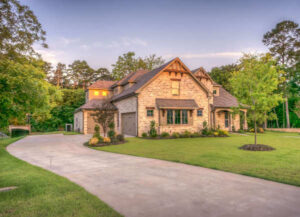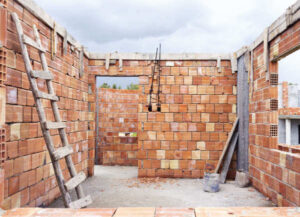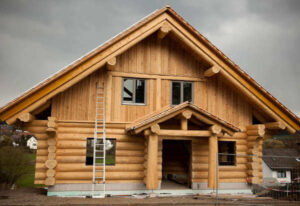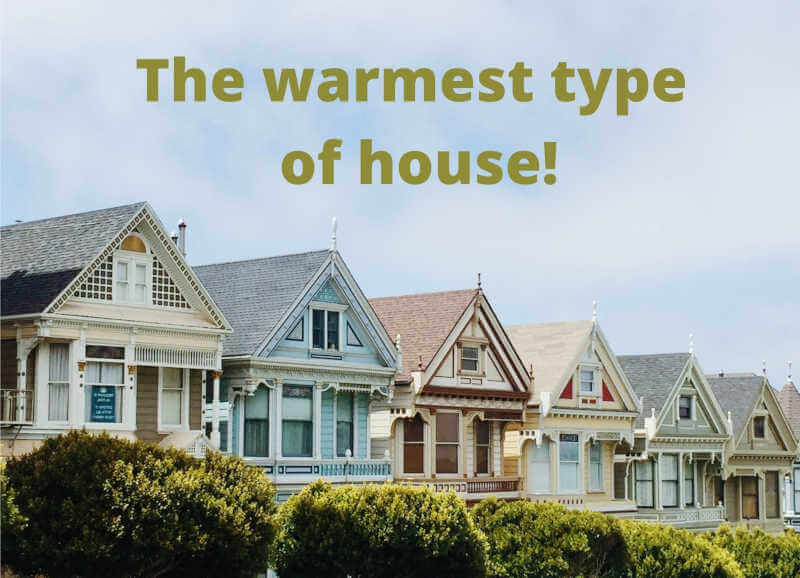When we talk about what makes a house so appealing, one of the main descriptions that are thrown out is cosy. To have a cosy home, you want to have the warmest house possible. But what is the warmest type of house?
Brick houses are the warmer type of house, but insulation is the key to having a warm house. Brick can absorb heat during the day and maintain a warm temperature for a longer time than other materials. The construction of a cavity wall and added insulation is key to keeping any type of house warm.
Other heavy materials like concrete are good for keeping a warm house. But there are ways to make any home one of the warmest houses on the block.
What type of house is the warmest?
The warmest type of house tends to be built from materials such as brick and stone that are paired with added insulation. Brick has an advantage in creating a warm house because it can absorb lots of heat throughout the day. This heat takes a long time to release from brick because of the thermal mass. So, the heat from the day won’t fully be released from a brick house until the early hours of the following morning. Pair the natural warmth with a heater, and a brick house will stay warm for a very long time. Consider the way bricks are used around a fireplace. The bricks are used here because they are more fire-resistant. They take much longer to warm up but keep heat in them long after the fire has been put out.
Good insulation also makes brick the warmest type of house. The best way to have a very warm brick house is to pair brick with insulation boards or stud walls filled with insulation material. The insulation material can be mineral wool, fibre, fibreglass, or foam insulation. This added insulation especially helps if you live in a very cold climate. The heat in the house will take much longer to seep out if it has to go through added insulation and brick walls.
What are the best materials that keep a house warm?
 Brick, concrete, and stone are the best materials that keep a house warm. All three of these materials have similar make-ups and functions to trap and release heat. Brick absorbs heat better than most other materials, but concrete and stone follow closely behind.
Brick, concrete, and stone are the best materials that keep a house warm. All three of these materials have similar make-ups and functions to trap and release heat. Brick absorbs heat better than most other materials, but concrete and stone follow closely behind.
Stone has a similar ability to keep warm, but it is considerably more expensive than brick. It also isn’t as porous, so doesn’t absorb heat quite as well. If you’re willing to spend the extra money, though, a stone house can look fantastic and still be really warm. You will want to add extra insulation for an extra cosy stone house.
Concrete is another option for a warmer house, though generally not favoured for aesthetic reasons. By itself, it also tends to be more expensive than brick. It can be cheaper when mixed with aggregate. Overall, though, brick still has the advantage as it is more aesthetically pleasing and is better for retaining heat.
Wooden houses are a popular option for warm houses in many colder areas, and they do certainly have advantages. They can heat up faster in some cases since the wood is a good thermal conductor. But, generally speaking, wooden houses need to be more robustly heated and insulated. This means that making a wooden house a warm house is going to be a much more expensive option than brick.
Is it expensive to build a warm house?
Building an extra warm house can be expensive, depending on the materials you use. But the thing to consider is the cost of building a warmer house over the cost of having to heat a house.
The most cost-effective option for a warm house is a brick house. Bricks are the most common building material, especially for home construction. Plus, most builders automatically pair brick houses with added insulation, so it isn’t an extra cost down the track. Bricks are the standard building material, which means modern houses are designed using them to create the warmest house possible. So, building a warm house doesn’t have to be very expensive if you go with standard builders.
Including all insulation materials, the guideline for a brick house construction is around €200 per square metre. So, a well-insulated brick house is really not more expensive than the average. And, again, it’s always going to be worth the cost.
Even if creating a warmer house costs more to build, you can save lots of money on heating costs. It’s better to build an energy-efficient home than spend thousands constantly trying to manage the temperature in your house. It is more expensive to build a wooden house and have to heat it than to pay extra for a brick house with insulation. So, the expense comes down to whether you build a warm house straight away or pay to heat any kind of house over the years.
What makes a house warmer?
The main factors that influence how warm a house includes the housing material, cavity walls, and insulation. As we’ve mentioned, the material of a house heavily influences how warm the house is. Building a house with durable materials that have good insulation, such as brick, will make a house warmer. Brick houses are warmer in winter and colder climates than most other houses.
Another factor that makes a house warmer is the use of cavity walls. Most quality builds these days are designed with cavity walls. This method involves using two layers of brick and leaving a space between them. This space is called a cavity. The cavity can stop heat from the inner brick wall from transferring to the outer wall. This keeps the warm air in the cavity, maintaining the temperature inside the house for longer.
The other important element that makes a house warmer is the insulation. Good insulation is the key to keeping heat inside a house for as long as possible. You can use foam or fibreglass insulation. The key is to ensure there’s solid, uniform insulation that flows throughout the house. This way you can be sure to make your whole house warmer and not just certain places.
What is the coldest type of house?
Simple log cabins are likely to be some of the coldest kinds of houses. They struggle to conduct and maintain heat the same way as other materials do. Keeping a log cabin warm in colder climates relies almost entirely on good central heating and insulation.
Older builds are also typically a lot colder for a number of reasons. Even old brick houses can be very cold because they weren’t constructed with a cavity, but just a simple layer of brick. Insulation will most likely have been added at some point, but they still won’t be as warm as those with a cavity.
While you’re considering the best material for the warmest house, check out our other resources including ‘is double brick better?’ For the best quality bricklaying and masonry tools, take a look at our Paragon Masonry Tools shop today!



